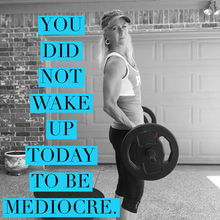9 Tips for a Faster Bike Ride
1. Spend time in the saddle. This means ride often. Like any other endurance sport, you need to put in the time to build your base, build strength, and get FASTER. I recommend 3-4 times a week with a key high intensity ride with intervals, a strength ride with hills or tempo efforts, and one long ride for endurance.
2. Ride with a group and preferably with cyclists that are slightly faster than you. Riding with a group teaches you crucial bike handling skills such as cornering, descending, climbing, stopping, reaching for your nutrition or water bottles, etc. When you ride with folks that are more experienced or faster than yourself, this forces you to get out of your comfort zone and push harder so you don't get dropped. The fastest cycling I've ever done has been with a group of athletes from the local cycling team. There were a few rides where I hung on for dear life, but after I got used to their pattern and tempo, I had no problem hanging with them.
3. Ride all year long, even in the winter. This means not hanging your road bike up in the garage for 4 months. Keep your bike on the trainer, go to Spin class, or ride outside when the weather permits. Do this regularly and consistently. It's important to recover during the off season, but there's no need to completely lose your bike fitness.
4. Get a professional bike fitting. This can be game changing for your ride. Your positioning on the bike can make a big difference in your riding efficiency and speed. You'll feel more comfortable and be less likely to suffer an injury with good positioning.
5. Use technology. A power meter is a good place to start. This can tell you exactly how hard you are working and help you stay in your designated HR training zones. Start with doing a FTP (functional threshold power) test to determine the average number of watts you can sustain over an hour. Also, there are all kinds of great apps such as Zwift, Strava, Garmin Connect, etc. to help you maintain and track your cycling data. Many of these apps are also a social community and it can be fun to challenge yourself through competition from other cyclists on certain segments. They accountability they provide is great too.
6. Do Speed Intervals and Threshold Rides. Speed intervalswill help you develop efficiency at high speeds. These should be mixed with low to moderate intensity in between efforts. Threshold rideswill help you increase the length of time that you can maintain higher speeds on the bike and develop power and endurance.
7. Strength Train. I can't emphasize this enough. The main goal with strength training is to create a strong foundation for all the muscles used in cycling. Strength training helps build power, endurance, and can benefit cycling performance. Below I am listing several of Ironman University's strength training moves for cyclists as well as a few of my own in no particular order:
1. Single Leg Dead Lift
2. Bent Over Rows
3. Barbell Dead Lift
4. Dumb Bell Front Raise
5. Dumb Bell Lateral Raise
6. Dumb Bell Reverse Fly
7. Dumb Bell Rows
8. Shoulder Press
9. Fire Hydrants
10. Squats
11. Glute Bridge
12.Good Mornings
13. Side Lunge R/L
14. Reverse Lunge
15. Medicine Ball slams
16. Monster Walk with Bands
17. Push-ups
18. Reverse Lunge with a Twist
19. Bulgarian Split Squats
20. Step Ups/Step Up Curl to Overhead Press
21. Plank Hold
22. Resistaball Curl
23. Supine or Resistaball Back Extensions
24. Resistaball Crunches
25. Walking Lunges
8. Get good at Tactics and Techniques
This is best done in the off season. Here are a few examples:
Tactics:
*Holding pace, cadence or power under certain conditions such as hills or heavy wind
*Practicing T1 and T2 transitions
*Practicing passing and falling out of the draft zone
*Practicing race day nutrition and timing strategies
Techniques:
*Cadence drills
*Pacing drills
*Pedal stroke drills
*Eating and drinking while on the bike
*Bike handling drills
9. Get a set of racing wheels. Although this is not completely necessary for some people, most serious competitive triathletes and cyclists have a set of racing wheels on their road bike or tri bike. I won't go into all of the research here, but I can speak from my own experience. I've done the same race twice, both with and without race wheels and my bike time for this particular Sprint Triathlon was about 2.5 minutes FASTER when I rode with racing wheels on the tri bike. Do some research before you buy a set of wheels and see which ones are a good fit for you and your race schedule.
Source:
u.ironman.com


























